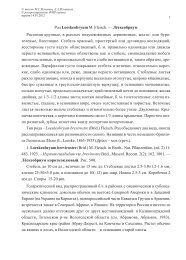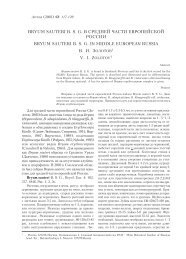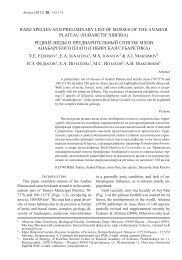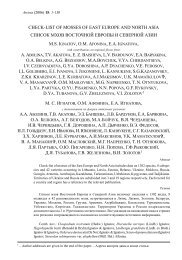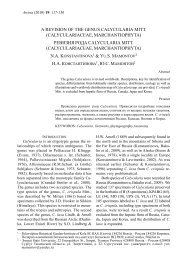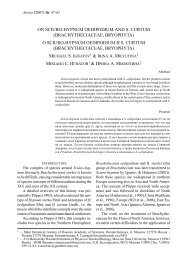THE GENUS BRYUM (BRYACEAE, MUSCI) IN MIDDLE ... - Arctoa
THE GENUS BRYUM (BRYACEAE, MUSCI) IN MIDDLE ... - Arctoa
THE GENUS BRYUM (BRYACEAE, MUSCI) IN MIDDLE ... - Arctoa
You also want an ePaper? Increase the reach of your titles
YUMPU automatically turns print PDFs into web optimized ePapers that Google loves.
198<br />
zling history of studies and a number of contradictory<br />
species concepts. The authors of Bryologia<br />
Europaea (Bruch & al., 1846), Warnstorf<br />
(1906), and Podpera (1952) recognized two<br />
species in this complex: autoicous B. pallescens<br />
and synoicous B. cirrhatum (corresponding to<br />
B. lonchocaulon in the present study). Nyholm<br />
(1958) suggested that autoicous B. pallescens<br />
and B. cirrhatum should be treated as synonymous,<br />
because she considered the autoicous and<br />
the synoicous + male sexual conditions not readily<br />
distinct. She separated B. creberrimum from B.<br />
pallescens relying mostly on spore size. Smith<br />
(1973, 1978) followed Nyholm in including B.<br />
cirrhatum in the synonymy of B. pallescens, and<br />
tried to find reliable characters for separating it<br />
from B. creberrimum. He measured/evaluated<br />
11 characters in 54 specimens and found that<br />
two are reliable: spore size, and width of endostome<br />
segment perforations. Crum & Anderson<br />
(1981) did not find these two characters useful<br />
for North American material. Instead, they used<br />
laminal cell shape as a key character; 2:1 in B.<br />
pallescens and 3:1 in B. creberrimum. Ochi (1959,<br />
1985) distinguished B. pallescens and B. cirrhatum,<br />
using a single character, autoicous vs. synoicous<br />
sexual condition. Savicz-Ljubitskaya<br />
(1954) and Savicz-Ljubitskaya & Smirnova<br />
(1970), in their treatments of Bryum for the<br />
bryoflora of the USSR, accepted 3 species: B.<br />
pallescens (autoicous); B. cirrhatum (polyoicous),<br />
and B. creberrimum (synoicous).<br />
My observations are as follows. First, I found<br />
only one truly autoicous collection: in ca. 30 inflorescences<br />
studied I found either numerous<br />
antheridia, or numerous archaegonia. This plant is<br />
rather tall with evenly arranged leaves below<br />
comose leaves, a relatively short excurrent costa,<br />
broad leaf border, and short laminal cells. Almost<br />
identical plants were seen from western Europe<br />
and the Caucasus, but they were rare in both these<br />
regions (listed below). These autoicous collections<br />
are referred here to B. pallescens. Other<br />
specimens are divided into two groups: (1) stem<br />
ends in synoicous inflorescence (in exceptional<br />
cases inflorescences has only archaegonia); subterminal<br />
shoots nearly always male; leaves +long<br />
V. I. ZOLOTOV<br />
acuminate with a long excurrent costa; awn<br />
(0.25-)0.4-0.65(-0.8) mm long, narrow, +flexuose<br />
and serrulate; leaf border relatively broad, 6(-7)<br />
rows; and (2) inflorescence synoicous, and subterminal<br />
shoots have also synoicous inflorescences<br />
(very rarely unsexual inflorescences were observed);<br />
leaves +shortly acuminate with a short<br />
excurrent costa; awn 0.2-0.4(-0.65) mm long, stout,<br />
straight and smooth or weakly serrulate; leaf<br />
border relatively narrow, 2-3(-4)-rows. I was able<br />
to sort 110 specimens of this group into two<br />
groups (50 and 60 specimens respectively), without<br />
significant difficulty, though poor specimens<br />
without developed subterminal shoots can be identified<br />
not so certainly. These two groups I refer<br />
to B. lonchocaulon and B. creberrimum respectively.<br />
An example of distribution of gametangia<br />
in 3 populations of B. lonchocaulon and 3 populations<br />
of B. creberrimum is presented in Fig. 87.<br />
In each population (2-)4-6 samples ca. 2 cm in<br />
diameter were taken, and in each sample 5 randomly<br />
selected shoots were studied. The proportion<br />
of gametangia was found to be rather stable<br />
(Fig. 87), which agree with my observation in<br />
other specimens.<br />
Since this concept is almost in agreement with<br />
the concept of B. cirrhatum and B. creberrimum<br />
of Savicz-Ljubitskaya (1954), I accept the names<br />
used by her, with the necessary nomenclatural<br />
corrections. Both these names must be considered<br />
as preliminary, and may not be appropriate for the<br />
following reasons. Bryum cirrhatum was found<br />
to be an illegitimate name and was replaced by<br />
B. lonchocaulon (Ochi, 1980), but Ochi (1959)<br />
considered B. cirrhatum as a synoicous species.<br />
Demaret (1986) described the type of B. creberrimum,<br />
and it does not correlate very well with<br />
the present concept, but falls better within the<br />
range of variability of B. lonchocaulon. A search<br />
for correct names (or verification of those used<br />
here) is needed, but it is a special task beyond the<br />
limits of the present study.<br />
Habitat: Found once, on a limestone outcrop.<br />
Specimen examined: Perm Prov., Bezgodov &<br />
Selivanov #228, 20.VI.1995, MW.<br />
Studied specimens of B. pallescens from other areas:<br />
1) Finland, Brotherus VII.1913, MW; 2) Brotherus:<br />
Fig. 85. Bryum pallescens Schleich. ex Schwaegr. (from Perm Prov., Bezgodov & Selivanov, 228, MW): 1-2 – capsules;<br />
3 – habit; 4 – part of endostome and inner surface of exostome tooth; 5 – outer surface of exostome tooth; 7 – upper<br />
laminal cells; 8-11 – perichaetial leaves; 12-14 – perigonial leaves; 15 – basal cells; 16 – mid-leaf cells (border recurved);<br />
17 – transverse leaf section. Scale bars: 2 mm for 1-3; 1 mm – 8-14; 200 μm – 7, 15-17; 100 μm – 4-6.



